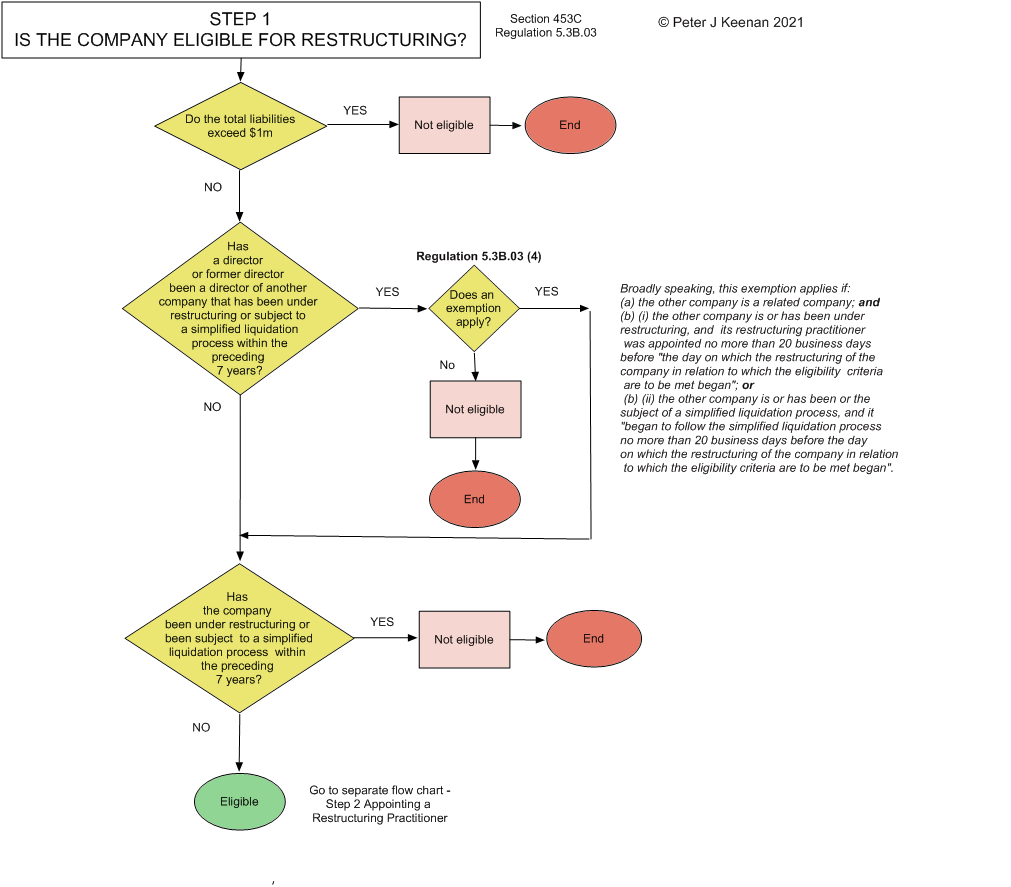Decide by following this flow chart:



Temporary restructuring relief documents – ASIC Form EX07 – 1 January 2021. A cover sheet for lodging director declarations relating to temporary restructuring relief and related documents. Includes Guide. PDF format. Link to ASIC.
Director/s declaration of eligibility for temporary relief – ASIC form (no number) 1 January 2021. Related document to ASIC Form EX07 – see above. PDF format. Link to ASIC.
ASIC FAQs for company directors about temporary restructuring relief . Online pages. Headings: 1. Overview of the temporary restructuring relief. 2. Eligibility for temporary restructuring relief. 3. How does temporary restructuring relief end? 4. What a director must do if they realise the company is no longer eligible for temporary restructuring relief. Link to ASIC.
ASIC Guide for directors to publishing a notice of the declaration on the Published Notices Website. Online pages. Link to ASIC.
Warning: These extracts DO NOT FULLY COVER the subject. For a much more complete picture read the extensive guidance given by Australian Securities and Investment Commission (ASIC) and/or the legislation (see below).
It is important directors seek advice from a trusted adviser such as a suitably qualified financial adviser, accountant, registered liquidator or lawyer if they are considering whether eligibility for temporary restructuring relief…. The temporary restructuring relief extends, to 31 March 2021, certain measures implemented by the government to assist companies continue to operate during the COVID- 19 pandemic…. Directors must act before 31 March 2021 if they wish to access the temporary restructuring relief…. A company can access temporary restructuring relief if, during the period 1 January 2021 to 31 March 2021, the company directors make the required declaration about the company’s eligibility for temporary restructuring relief; and publish notice of the making of the declaration on the Published Notices Website. To ensure the temporary restructuring relief does not cease, directors must also give ASIC a copy of their declaration no later than 5 business days after it is made…. The period of relief only begins when the directors have made a declaration about the company’s eligibility for temporary restructuring relief and published notice of making the declaration on the Published Notices Website…. The initial temporary restructuring relief period can be extended for a further one month in some circumstances….

The 162 page report, issued on 24 February 2017, is titled Phoenix Activity: Recommendations On Detection, Disruption And Enforcement.
In the Executive Summary the authors state:
Harmful phoenix activity, left unchecked, has the capacity to undermine Australia’s revenue base and the competitive ‘level playing field’. It is wrong that legitimate business operators, paying taxes, wages and other debts, might be driven out of business by those engaging in harmful phoenix activity. Minimising business distrust caused by harmful phoenix activity can lower the cost of finance and make it more widely available. If less tax revenue is fraudulently avoided, the economy and society as a whole benefit. If fewer employee entitlements are lost as a result of harmful phoenix activity, there is likely to be less reliance on the Fair Entitlements Guarantee, freeing up government resources for other purposes.
What was described in earlier reports as “fraudulent phoenix activity” is described in the final report as “harmful phoenix activity”.
CLICK HERE to read and/or download a copy of the report.
The authors are Professor Helen Anderson, Professor Ian Ramsay, Professor Michelle Welsh and research fellow Mr Jasper Hedges.
Their Phoenix Project (“Phoenix Activity: Regulating Fraudulent Use of the Corporate Form”) “seeks to enhance Australia’s economic stability by determining the best methods of addressing fraudulent use of the corporate form without unduly inhibiting its proper use”. The project was launched in 3 years ago.
Analysis and highlights of the report will be posted here in due course.